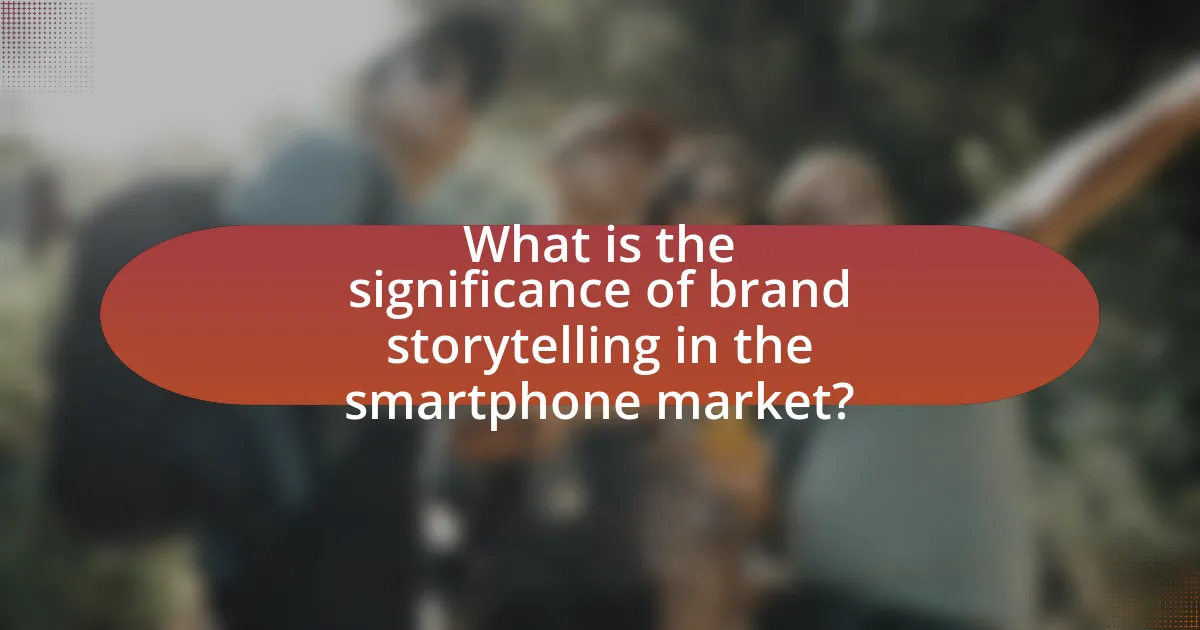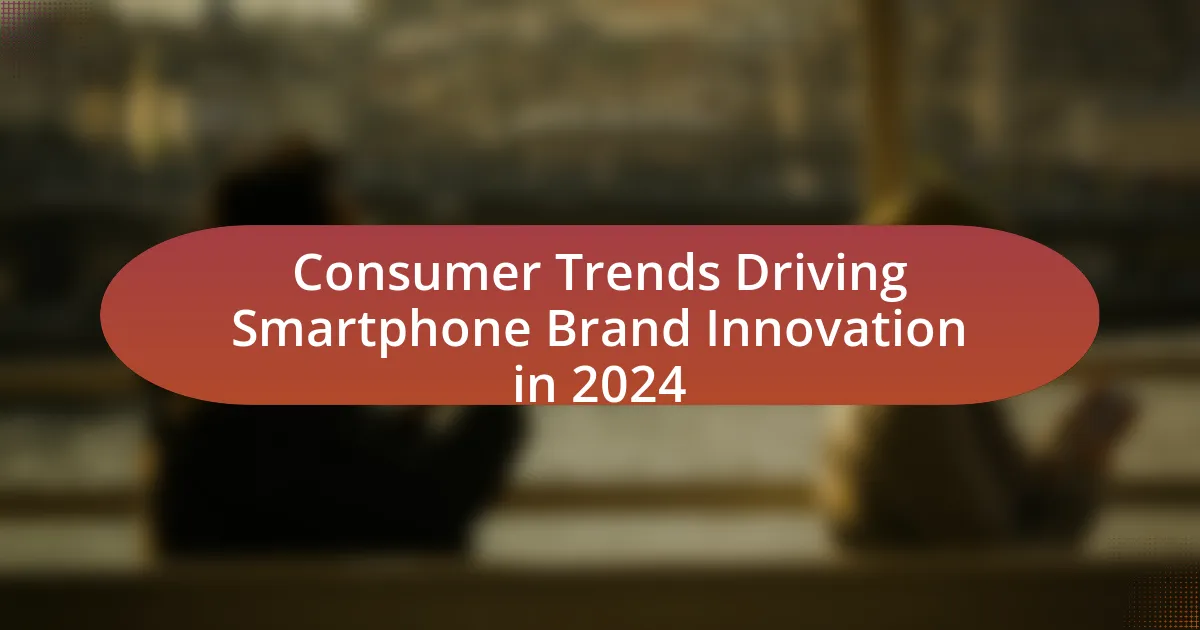The article focuses on the significance of brand storytelling in the competitive smartphone market, emphasizing how emotional connections between consumers and brands influence purchasing decisions and enhance brand loyalty. It explores how storytelling differentiates smartphone brands, highlighting examples from companies like Apple and Samsung, and identifies key elements that make a brand story compelling, such as authenticity and innovation. Additionally, the article discusses the impact of emotional connections on consumer engagement, the importance of adapting narratives to market trends, and the challenges brands face in maintaining authenticity amidst competition. It concludes with best practices for effective storytelling and the role of emerging technologies and social media in shaping future brand narratives.

What is the significance of brand storytelling in the smartphone market?
Brand storytelling is significant in the smartphone market as it creates emotional connections between consumers and brands, influencing purchasing decisions. This connection is crucial in a saturated market where differentiation is challenging; compelling narratives can enhance brand loyalty and consumer engagement. For instance, Apple effectively uses storytelling to convey innovation and lifestyle, resulting in a 2022 brand loyalty rate of 91% among its users, according to a survey by SellCell. This demonstrates that effective brand storytelling not only enhances brand perception but also drives sales and customer retention in the competitive smartphone landscape.
How does brand storytelling differentiate smartphone brands?
Brand storytelling differentiates smartphone brands by creating emotional connections with consumers, which enhances brand loyalty and preference. For instance, Apple uses storytelling to emphasize innovation and user experience, portraying its products as tools for creativity and self-expression. This narrative resonates with consumers, leading to a strong brand identity and customer loyalty, as evidenced by Apple’s consistent market leadership and high customer satisfaction ratings. In contrast, brands like Samsung focus on storytelling that highlights technological advancements and versatility, appealing to a different segment of consumers who prioritize functionality and cutting-edge features. This strategic use of storytelling allows smartphone brands to carve out distinct market positions and foster deeper relationships with their target audiences.
What elements make a brand story compelling in the smartphone industry?
A compelling brand story in the smartphone industry includes authenticity, emotional connection, innovation, and customer-centric narratives. Authenticity establishes trust, as brands like Apple and Samsung share their origins and values, resonating with consumers. Emotional connection is vital; for instance, campaigns that highlight personal stories or societal impact, such as Google’s “Year in Search,” evoke feelings that strengthen brand loyalty. Innovation showcases a brand’s commitment to progress, exemplified by companies that emphasize cutting-edge technology and design, like OnePlus with its focus on user feedback. Lastly, customer-centric narratives that incorporate user experiences and testimonials, as seen in Xiaomi’s community-driven approach, enhance relatability and engagement. These elements collectively create a memorable and impactful brand story that stands out in a competitive market.
How do emotional connections enhance brand storytelling?
Emotional connections enhance brand storytelling by fostering deeper engagement and loyalty among consumers. When brands evoke emotions through storytelling, they create memorable experiences that resonate with their audience, leading to stronger brand affinity. Research indicates that emotionally connected customers are more likely to remain loyal, with studies showing that emotionally engaged customers are 23% more likely to recommend a brand. This connection transforms a brand’s narrative into a relatable experience, making it more impactful in a competitive market like smartphones, where differentiation is crucial.
Why is brand storytelling essential for consumer engagement?
Brand storytelling is essential for consumer engagement because it creates an emotional connection between the brand and its audience. This connection fosters loyalty and encourages consumers to identify with the brand’s values and mission. Research indicates that storytelling can increase brand recall by up to 22 times compared to traditional advertising methods, as narratives resonate more deeply with consumers. Additionally, brands that effectively utilize storytelling often see higher engagement rates, with studies showing that 92% of consumers prefer ads that feel like a story. This demonstrates that compelling narratives not only capture attention but also drive consumer behavior in the competitive smartphone market.
How does storytelling influence consumer purchasing decisions?
Storytelling significantly influences consumer purchasing decisions by creating emotional connections and enhancing brand relatability. When brands share compelling narratives, they engage consumers on a personal level, making products more memorable and desirable. Research indicates that 92% of consumers prefer ads that feel like a story, demonstrating that storytelling can lead to increased brand loyalty and higher sales. For instance, Apple effectively uses storytelling in its marketing campaigns, showcasing how its products fit into users’ lives, which has contributed to its strong market position in the smartphone industry.
What role does authenticity play in brand storytelling?
Authenticity is crucial in brand storytelling as it fosters trust and emotional connection with consumers. When brands present genuine narratives that reflect their values and mission, they resonate more deeply with their audience, leading to increased loyalty and engagement. Research indicates that 86% of consumers consider authenticity important when deciding what brands to support, highlighting the impact of authentic storytelling on consumer behavior. In the competitive smartphone market, brands that effectively communicate their authentic stories can differentiate themselves, build stronger relationships, and ultimately drive sales.

How do successful smartphone brands implement storytelling?
Successful smartphone brands implement storytelling by creating narratives that resonate emotionally with consumers, highlighting user experiences and brand values. For instance, Apple often emphasizes innovation and creativity in its marketing campaigns, showcasing how its products enhance users’ lives through personal stories and testimonials. Samsung, on the other hand, focuses on the versatility and functionality of its devices, using storytelling to illustrate how its smartphones fit into various lifestyles and everyday scenarios. These brands leverage multimedia content, such as videos and social media, to engage audiences and reinforce their messages, ultimately fostering a deeper connection with consumers. This approach is supported by research indicating that emotional storytelling can increase brand loyalty and consumer engagement, making it a vital strategy in the competitive smartphone market.
What strategies do leading brands use for effective storytelling?
Leading brands use several strategies for effective storytelling, including creating relatable narratives, leveraging emotional connections, and utilizing multi-channel engagement. Relatable narratives help consumers see themselves in the brand’s story, fostering a sense of belonging. Emotional connections are established through storytelling that resonates with the audience’s values and experiences, which can increase brand loyalty; for instance, Apple’s campaigns often highlight personal stories that evoke strong emotions. Multi-channel engagement ensures that the brand’s story reaches consumers through various platforms, enhancing visibility and impact; brands like Samsung effectively use social media, video content, and traditional advertising to tell cohesive stories across different touchpoints. These strategies collectively enhance brand perception and consumer engagement in the competitive smartphone market.
How do visual elements contribute to brand storytelling?
Visual elements significantly enhance brand storytelling by creating immediate emotional connections and conveying messages quickly. For instance, imagery, color schemes, and typography can evoke specific feelings and associations, which help to establish a brand’s identity and values. Research indicates that visuals are processed 60,000 times faster than text, making them crucial for capturing consumer attention in a competitive market like smartphones. Brands that effectively utilize visual storytelling, such as Apple with its minimalist design and vibrant imagery, can differentiate themselves and foster loyalty among consumers.
What platforms are most effective for sharing brand stories?
Social media platforms, particularly Instagram, Facebook, and TikTok, are most effective for sharing brand stories. These platforms enable brands to engage visually and interactively with their audience, which is crucial in the competitive smartphone market. For instance, Instagram’s emphasis on visual content allows brands to showcase their products and narratives through images and videos, leading to higher engagement rates. According to a study by Hootsuite, 60% of users discover new products on Instagram, highlighting its effectiveness in brand storytelling. Facebook’s extensive user base and targeted advertising capabilities further enhance a brand’s reach and storytelling potential. TikTok’s short-form video format encourages creativity and authenticity, making it an ideal platform for brands to connect with younger audiences.
How do brand stories evolve with market trends?
Brand stories evolve with market trends by adapting their narratives to reflect changing consumer values, technological advancements, and competitive dynamics. For instance, as sustainability becomes a priority for consumers, brands like Apple and Samsung have integrated eco-friendly practices into their storytelling, emphasizing their commitment to environmental responsibility. This shift is supported by data indicating that 66% of global consumers are willing to pay more for sustainable brands, highlighting the necessity for brand narratives to align with market expectations. Additionally, the rise of digital communication has led brands to leverage social media platforms for storytelling, allowing for real-time engagement and feedback, which further shapes their narratives in response to consumer sentiment.
What impact do technological advancements have on storytelling approaches?
Technological advancements significantly enhance storytelling approaches by enabling more immersive and interactive experiences. For instance, the integration of augmented reality (AR) and virtual reality (VR) allows brands to create engaging narratives that consumers can experience firsthand, leading to deeper emotional connections. According to a study by PwC, 78% of consumers believe that AR and VR can enhance their shopping experience, demonstrating the effectiveness of these technologies in storytelling. Additionally, advancements in data analytics allow brands to tailor their narratives to specific audience segments, increasing relevance and impact. This data-driven approach has been shown to improve customer engagement by up to 50%, as reported by McKinsey. Thus, technological advancements not only transform how stories are told but also significantly improve their effectiveness in the competitive smartphone market.
How can brands adapt their stories to changing consumer preferences?
Brands can adapt their stories to changing consumer preferences by actively engaging in market research and utilizing data analytics to understand evolving consumer behaviors and values. For instance, brands can leverage social media insights and customer feedback to identify trends, allowing them to tailor their narratives to resonate with current consumer sentiments. A study by Nielsen found that 66% of consumers are willing to pay more for brands that are transparent about their practices, highlighting the importance of aligning brand stories with consumer values such as sustainability and ethical sourcing. By continuously monitoring these shifts and adjusting their messaging accordingly, brands can maintain relevance and foster deeper connections with their audience.

What challenges do brands face in storytelling within the smartphone market?
Brands face significant challenges in storytelling within the smartphone market due to intense competition, rapid technological advancements, and consumer skepticism. The smartphone market is saturated with numerous brands, making it difficult for any single brand to stand out and create a unique narrative that resonates with consumers. Additionally, the fast-paced nature of technology means that storytelling must constantly evolve to keep up with new features and innovations, which can dilute the brand’s core message. Consumer skepticism further complicates storytelling efforts, as potential buyers often question the authenticity of brand narratives, especially when they perceive them as marketing gimmicks rather than genuine stories. According to a 2022 survey by Deloitte, 62% of consumers reported that they are more likely to trust brands that share authentic stories, highlighting the importance of credibility in brand storytelling.
How do competitive pressures affect brand storytelling?
Competitive pressures significantly influence brand storytelling by compelling brands to differentiate themselves through unique narratives. In the highly saturated smartphone market, companies like Apple and Samsung utilize storytelling to highlight their innovation, user experience, and emotional connections with consumers. For instance, Apple’s “Think Different” campaign effectively positioned the brand as a leader in creativity and innovation, setting it apart from competitors. This strategic use of storytelling not only enhances brand identity but also fosters customer loyalty, as consumers are more likely to engage with brands that resonate with their values and aspirations.
What common pitfalls should brands avoid in their storytelling efforts?
Brands should avoid being overly complex in their storytelling efforts. Simplifying the narrative ensures that the message is clear and resonates with the audience. Research indicates that 86% of consumers prefer brands that communicate in a straightforward manner, as complex stories can lead to confusion and disengagement. Additionally, brands should steer clear of inconsistency in their messaging; maintaining a cohesive narrative across all platforms strengthens brand identity and trust. Inconsistent storytelling can dilute brand perception, as seen in studies where 70% of consumers reported confusion when brands change their messaging frequently. Lastly, brands must avoid neglecting their audience’s values and emotions; storytelling that fails to connect on an emotional level can result in a lack of engagement, with 55% of consumers stating they are more likely to support brands that align with their personal values.
How can brands measure the effectiveness of their storytelling?
Brands can measure the effectiveness of their storytelling through metrics such as engagement rates, brand recall, and conversion rates. Engagement rates can be assessed by analyzing social media interactions, comments, and shares related to storytelling content, indicating how well the narrative resonates with the audience. Brand recall can be measured through surveys that evaluate how well consumers remember the brand’s story and its emotional impact, which is crucial in a competitive market. Conversion rates, tracked through analytics tools, reveal how storytelling influences purchasing decisions, providing concrete evidence of its effectiveness in driving sales.
What are the future trends in brand storytelling for smartphones?
Future trends in brand storytelling for smartphones include increased personalization, immersive experiences through augmented reality (AR), and the use of data-driven narratives. Personalization allows brands to tailor stories to individual consumer preferences, enhancing engagement; for instance, 80% of consumers are more likely to make a purchase when brands offer personalized experiences. Immersive storytelling through AR enables users to interact with products in a virtual space, creating memorable experiences that can lead to higher brand loyalty. Additionally, leveraging data analytics helps brands craft narratives that resonate with target audiences, as evidenced by the fact that data-driven marketing can increase ROI by up to 5-8 times. These trends indicate a shift towards more engaging, consumer-centric storytelling in the smartphone market.
How might emerging technologies shape brand narratives?
Emerging technologies shape brand narratives by enabling more immersive and interactive storytelling experiences. For instance, augmented reality (AR) and virtual reality (VR) allow brands to create engaging environments where consumers can experience products in a more personal and memorable way. According to a study by the Harvard Business Review, brands that utilize AR in their marketing strategies can increase customer engagement by up to 70%. Additionally, artificial intelligence (AI) facilitates personalized content delivery, allowing brands to tailor narratives to individual consumer preferences, thereby enhancing emotional connections. This personalization can lead to a 20% increase in customer loyalty, as reported by McKinsey & Company. Overall, these technologies transform traditional brand narratives into dynamic, consumer-centric experiences that resonate more deeply with audiences.
What role will social media play in the future of brand storytelling?
Social media will play a crucial role in the future of brand storytelling by serving as a primary platform for direct engagement and narrative dissemination. As smartphone users increasingly rely on social media for information and entertainment, brands will leverage these platforms to create authentic, interactive stories that resonate with their audience. According to a 2021 report by Hootsuite, 54% of social media users use these platforms to research products, highlighting the importance of storytelling in influencing purchasing decisions. This trend indicates that brands must adapt their storytelling strategies to be more visually engaging and shareable, utilizing formats like short videos and live streams to capture attention effectively.
What best practices can brands follow for effective storytelling?
Brands can follow several best practices for effective storytelling, including creating a clear narrative, understanding the audience, and leveraging emotional connections. A clear narrative helps convey the brand’s mission and values, making it easier for consumers to relate. Understanding the audience allows brands to tailor their stories to resonate with specific demographics, enhancing engagement. Leveraging emotional connections is crucial, as studies show that emotionally charged stories can increase brand loyalty by up to 23%. By integrating these practices, brands can effectively differentiate themselves in the competitive smartphone market.
How can brands ensure their stories resonate with their target audience?
Brands can ensure their stories resonate with their target audience by deeply understanding their audience’s values, preferences, and pain points. Conducting thorough market research, including surveys and focus groups, allows brands to gather insights into what their audience cares about. For instance, a study by Nielsen found that 92% of consumers prefer ads that feel like a story, highlighting the effectiveness of narrative in engaging audiences. By aligning their brand narratives with these insights, brands can create authentic and relatable stories that foster emotional connections, ultimately enhancing brand loyalty and driving sales in the competitive smartphone market.
What are key takeaways for brands looking to enhance their storytelling approach?
Brands looking to enhance their storytelling approach should focus on authenticity, emotional connection, and audience engagement. Authenticity builds trust; for instance, brands like Apple emphasize their commitment to innovation and quality, resonating with consumers who value these traits. Emotional connection can be achieved through relatable narratives, as seen in campaigns by Samsung that highlight personal stories and experiences with their devices. Lastly, engaging the audience through interactive content, such as user-generated stories or social media campaigns, fosters community and loyalty, which is crucial in the competitive smartphone market.




